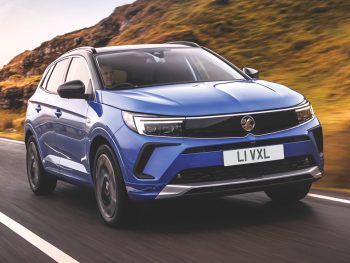Road Test: Vauxhall Grandland
Plug-in hybrid technology and upgrades inside and out for the mid-size SUV. By John Challen.

The range for the new Grandland has been massively simplified
Stellantis announced its ‘Dare Forward 2030’ mid-term plan in March, with – naturally – a huge emphasis on what is will be bringing to the market from an EV perspective. From Vauxhall’s point of view, that means all-new fully electric models and the next generation of existing products going over to battery-power only.
That, however, is for the future – at the current time, the UK brand’s big current news is the latest generation Grandland (no X anymore). The original model, introduced in 2018, performed admirably in the market, shifting 70k units in what is a very competitive market.
The range for the new model has been massively simplified. While Grandland X offered six trims and 27 derivatives, Grandland (no X) goes for three and 11 respectively. There’s a clear distinction between the trio, with base model Design offering value, GS Line representing a more sporty proposition and Ultimate adding a bit of luxury. Vauxhall expects the bulk of the orders for Grandland to be GS Line (60%), with Ultimate accounting for 30% of the business.
Externally, there are a number of upgrades to the overall appearance of the car, but it’s inside where drivers will really appreciate the improvements. Vauxhall’s PurePanel (as part of the PureSense package) comprises two large screens – the main 12-inch instrument cluster (7-inch in Design) and a 10-inch central one angled towards the driver. Not only does it provide a lot of information across the dual displays, but those details are presented in a clear and easy-to-navigate way. Helpfully, there is also a strip of physical buttons for easy access to features that are used regularly.
As part of PureConnect, all the new cars feature Apple CarPlay and Android Auto as standard, while wireless charging is standard on Ultimate models.
While PureConnect aids connectivitly, PureSense is all about safety features such as lane keep assist, blind spot alert and speed sign recognition. Grandland is also the first Vauxhall to offer a night vision system – available as cost option on the car. The technology’s camera detects animals and pedestrians up to 100m in the distance.
Grandland is built on Vauxhall’s EMP2 platform, which offers a base for petrol, diesel and hybrid offerings. Vauxhall says that the new Grandland aims to build on the current increasing market share for PHEV, the battery-electric version of the car being offered in GS Line and Ultimate trims.
From a fleet point of view, the Hybrid-e makes a lot of sense. Featuring a 13.2kW battery that can be fully charged in under four hours, the car can travel up to 39 miles using only electric power.
CAP reports stronger residual values for new Grandland, compared with the outgoing model. There’s an increase from 41% to 46%, depending on model and powertrain choice, which should make it an attractive proposition for fleets. A clear and competitive pricing strategy – starting at just over £25k for the base petrol and £33,765 for the PHEV – will also help.
IN BRIEF
WHAT IS IT? C-SUV
HOW MUCH? from £25,535
ECONOMY? 45.6-192mpg
EMISSIONS? 31-146/km
Key fleet model: 1.6-litre Plug-in Hybrid-e
Pro’s: Rear space; clear displays; good RVs
Cons: Interior noise; intermittent stop-start
7-word summary: Competitively priced SUV with much to admire
Also consider: Peugeot 3008 / Volvo XC40 / Hyundai Tuscon















